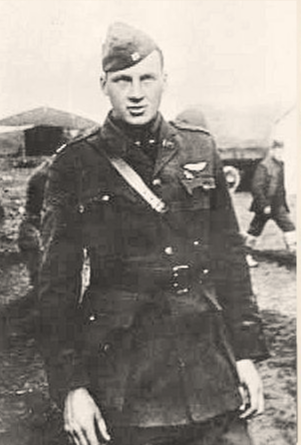Vertical Divider

“Ham” Coolidge, as his family called him, was born in Brookline in 1895. As a young man, he began studying at Harvard but left, with his close friend Quentin Roosevelt, to enlist in the Aviation Section of the U.S. Army Signal Corps. He studied flight training at MIT before being sent to France.
Coolidge arrived at the front after he was assigned to the 94th Aero Squadron. He was credited with taking down 9 enemy aircraft in aerial combat, and was promoted to Captain several weeks before his death.
Coolidge understood the dangers of war, and experienced a great loss when his friend Quentin was killed in action. But Coolidge wrote in a letter home that,
“Death is certainly not a black unmentionable thing, and I feel...that dead people should be talked of just as if they were alive...To me Quentin is just away somewhere...I miss him the way I miss Mother and the family, for his personality or spirit are just as real and vivid as they ever were.”
On October 28, 1918, Ham’s plane took a direct hit from anti-aircraft shell near Grandpre, France. As shared with the King’s Chapel congregation several months after Ham’s death:
Ham was “one of the four New England heroes cited recently for extraordinary acts of bravery and awarded the distinguished service medal...Leading a protection protocol of the squadron, Captain Coolidge went to the assistance of two observation planes which were attacked by six German machines. Observing this maneuver, the enemy sent up a terrific barrage from anti-aircraft guns. Disregarding the extreme danger, Captain Coolidge dived straight into the barrage, and his plane was struck and sent down in flames. “
He had just turned 23 years old.
A fellow pilot named Eddie Rickenbacker and a priest were able to locate Ham’s body and give him a proper burial. In his memoirs, Rickenbacker shared:
“Amid the continuous whines of passing shells we laid the poor mangled body of Captain Hamilton Coolidge in its last resting place. Over the grave was placed a Cross suitably engraved with his name, rank and the date of his tragic death. A wreath of flowers was laid at the foot of the cross. Then with uncovered head I took a photograph of the grave, which later was sent "back home" to the family who mourned for one of the most gallant gentlemen who ever fought in France.”
In finding Hamilton Coolidge, burying him, and creating a makeshift memorial, Eddie Rickenbacker helped preserve Coolidge’s memory, not only in the community where his plane went down, but also for his loved ones back home.
In the years following Coolidge's death, his family published his wartime letters, which provide a powerful and personal written record of one young man's experiences during the First World War.
Coolidge arrived at the front after he was assigned to the 94th Aero Squadron. He was credited with taking down 9 enemy aircraft in aerial combat, and was promoted to Captain several weeks before his death.
Coolidge understood the dangers of war, and experienced a great loss when his friend Quentin was killed in action. But Coolidge wrote in a letter home that,
“Death is certainly not a black unmentionable thing, and I feel...that dead people should be talked of just as if they were alive...To me Quentin is just away somewhere...I miss him the way I miss Mother and the family, for his personality or spirit are just as real and vivid as they ever were.”
On October 28, 1918, Ham’s plane took a direct hit from anti-aircraft shell near Grandpre, France. As shared with the King’s Chapel congregation several months after Ham’s death:
Ham was “one of the four New England heroes cited recently for extraordinary acts of bravery and awarded the distinguished service medal...Leading a protection protocol of the squadron, Captain Coolidge went to the assistance of two observation planes which were attacked by six German machines. Observing this maneuver, the enemy sent up a terrific barrage from anti-aircraft guns. Disregarding the extreme danger, Captain Coolidge dived straight into the barrage, and his plane was struck and sent down in flames. “
He had just turned 23 years old.
A fellow pilot named Eddie Rickenbacker and a priest were able to locate Ham’s body and give him a proper burial. In his memoirs, Rickenbacker shared:
“Amid the continuous whines of passing shells we laid the poor mangled body of Captain Hamilton Coolidge in its last resting place. Over the grave was placed a Cross suitably engraved with his name, rank and the date of his tragic death. A wreath of flowers was laid at the foot of the cross. Then with uncovered head I took a photograph of the grave, which later was sent "back home" to the family who mourned for one of the most gallant gentlemen who ever fought in France.”
In finding Hamilton Coolidge, burying him, and creating a makeshift memorial, Eddie Rickenbacker helped preserve Coolidge’s memory, not only in the community where his plane went down, but also for his loved ones back home.
In the years following Coolidge's death, his family published his wartime letters, which provide a powerful and personal written record of one young man's experiences during the First World War.
